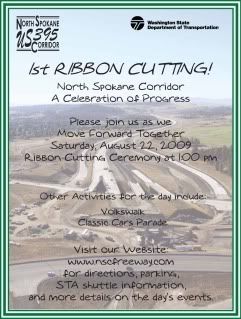North Spokane Corridor ready to cut the ribbon. (Light rail anyone?)
 This might come as a shock but on August 22nd, there will be a ribbon cutting ceremony for the first drivable link of the North Spokane Corridor between Francis/Freya and Farwell Road, a distance of approximately three and a half miles.
This might come as a shock but on August 22nd, there will be a ribbon cutting ceremony for the first drivable link of the North Spokane Corridor between Francis/Freya and Farwell Road, a distance of approximately three and a half miles.
(You can watch a five minute aerial fly through of the NSC construction progress here, showing animation of what the freeway will look like when portions open up over the next several years.)
Originally proposed in 1946, the NSC project, according to the most recent figures available at WSDOT, estimated cost is $1.6 billion in 2008 dollars but over a 20-year build out plan, with estimated risk and inflation variables included, the cost is $3.0 billion. Last fall lawmakers trimmed costs on a three-mile stretch from Francis Avenue south to the Spokane River. “Instead of building a Cadillac, we’re building a Chevy,” said state Sen. Chris Marr at the time. “It’ll get us where we need to go, and we can always upgrade.”
But sprawl is really what we’re upgrading to.
In 2005, urban planner Bill Grimes examined the effects I-90 had on developments in the Spokane Valley, believing the rural communities in the north would see auto-centric development like what’s currently viewable in Post Falls and Liberty Lake. On this front, there was strangely zero dialogue about the NSC impact on growth management; we let the freeway roll over us when nobody was looking and now it’s there. 
(Image courtesy of Inland Rail.)
A push for something new and more sustainable is needed because a road proposed in 1946 finally coming to fruition today is backward. It’s archaic to build a freeway as a way out of congestion, in this case to bypass Division St, rather than supporting initiatives to make us drive less frequently. Where’s the dialogue on light rail which concentrates development, leading to the growth of small urban centers around main stops? Even the Washington State University’s Social and Economic Sciences Research Center conducted a survey showing 73 percent of Spokane residents favored construction of light rail with estimated costs at $600 million, one fifth of NSC. Consider this while state engineers glorify short-term solutions that produce more of the same consequences, polluting the air and damaging small business, for the sole purpose of changing traffic flow.
